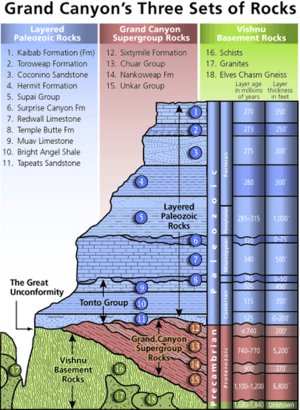Stratigraphic column facts for kids
A stratigraphic column is like a special map that shows the different layers of rock or soil found in one place. Imagine digging a very deep hole: you would see different layers, one on top of another. Geologists use these columns to understand Earth's history. The oldest layers are always at the bottom, and the newest ones are at the top. This helps scientists learn about past environments, climates, and even ancient life.
Contents
What is a Stratigraphic Column?
A stratigraphic column is a diagram that shows the order of rock layers, called "strata," in a specific area. Think of it like a stack of pancakes, where each pancake is a different layer of rock. Geologists, who study Earth, use these columns to see what rocks are present. They also use them to understand how old the layers are and what events happened long ago.
Reading the Layers of Time
When you look at a stratigraphic column, the oldest layers are always at the very bottom. The layers get younger as you move up the column. This is because new layers of rock or sediment are usually laid down on top of older ones. This simple rule helps scientists figure out the timeline of Earth's past.
How Geologists Use These Columns
Geologists use stratigraphic columns for many reasons. They can help them:
- Understand the history of an area, like if it was once covered by an ocean or a desert.
- Find important resources like oil, gas, or water, which are often found in specific rock layers.
- Study fossils to learn about ancient plants and animals that lived in different time periods.
- Compare rock layers from different places around the world. This helps them build a global picture of Earth's history.
See also
 In Spanish: Columna estratigráfica para niños
In Spanish: Columna estratigráfica para niños


